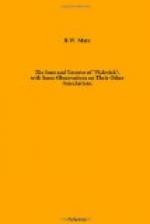This was the inn, then, to which Mr. Pickwick and Mr. Wardle came in search of the runaway couple, and Sam Weller was the first person they interviewed on the subject. The reader will refer to Chapter X of the book should he want his memory refreshed regarding the amusing scene with Sam, which has been so faithfully pictured by Phiz in one of his illustrations. How they discovered the misguided Rachael, how they bought off the adventurer, Jingle, and how Mr. Pickwick, Wardle and the deserted lady set forth the next day by the Muggleton heavy coach is duly set forth in Dickens’s own way.
The “White Hart” remained very much as Dickens found it and described it in 1836 until it was finally demolished in 1889. Following the advent of railways it lost a good deal of its glamour, and in its last years the old galleries on two of its sides were let out in tenements, and the presence of the occupants gave a certain animation to the scene. In the large inner yard were some quaint old house which were crowded with lodgers, but it still hung on to its old traditions of the coaching times, and even up to its last days the old inn was the halting-place of the last of the old-fashioned omnibuses which plied between London Bridge and Clapham.
Nothing now remains to remind us of the old inn which Dickens and Sam Weller have made immortal in the annals of coaching but a narrow turning bearing its name, where is established a Sam Weller Club.
CHAPTER V
“La Belle Sauvage” And the “Marquis of Granby,” Dorking
“La Belle Sauvage” has, like many other historic inns, gone into the limbo of past, if not of forgotten, things, leaving nothing but its name denoting a cul-de-sac, to remind the present generation of its one-time fame.
This was the inn where Tony Weller, resplendent in many layers of cloth cape and huge brimmed hat, stopped “wen he drove up” on the box seat of one of the stage coaches of the period. For Tony was, as everybody knows, a coachman typical of the period of the book, and the “Belle Savage” (the spelling of “savage” here follows the fashion of the period referred to) was where he started and ended his journeys in London. But the anecdote related by his son of how he was hoodwinked into taking out a licence to marry Mrs. Clarke contains the chief of the only two actual references to the fact that his head-quarters were the “Belle Savage,” as he called it. It is certainly recorded that he started from the “Bull” in Whitechapel when he drove the Pickwickians to Ipswich, but it is the “Belle Savage” that is associated with his name.
“‘What’s your name, sir?’ says the lawyer.
“‘Tony Weller,’ says my father. ‘Parish?’ says the lawyer. ’Belle Savage,’ says my father; for he stopped there wen he drove up, and he know’d nothing about parishes, he didn’t.”




